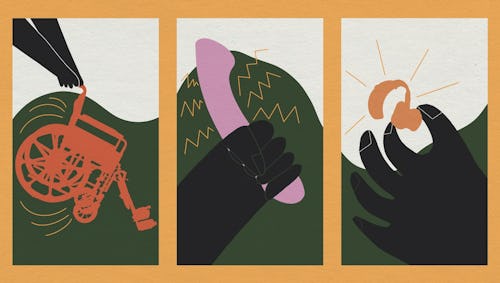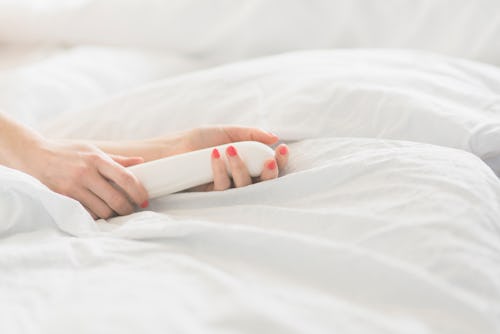
The sex toy industry is amidst a branding overhaul. Spurred on by booming pandemic sales and the growing popularity of smart sex toys, a new image of pleasure is emerging. What used to be skeevy storefronts crowded with phallic objects are now modern start-ups often headed by women and queer folx with a strong and intentional commitment to self-induced joy.
Even during this much-needed masturbatory evolution, there’s a gaping void in the industry. Sex toys are still generally marketed as a way to snag and orgasm sans partner or to rejuvenate up a relationship. These are valid reasons to buy one, but what’s missing from this conversation is disabled folx. Sex toys aren’t just play things for many in the disabled community, but powerful assistive technology that upends an abelist, anti-pleasure culture.
Assistive tech is as any product, piece of equipment, or system that enhances “learning, working, and daily living for persons with disabilities.” This kind of technology can look like speech-to-text software, a wheelchair, or a specialized keyboard. But what makes assistive tech so important — and refreshing— is that it's not meant to fix, cure, or rehabilitate disabled people, but rather meet people where they’re at. Unlike surgical procedures, physical therapy, or a revolving door of specialists and doctors, assistive tech invites ease and functionality (as opposed to disruption) into the lives of disabled people.
Sex, like all assistive tech, has a big influence over quality of life. But disabled people such as myself often occupy a difficult, contradictory, space in the sexual landscape. Infantilization, desexualization, and medicalization all form the noxious cultural beliefs that neglect — and stigmatize — disabled individuals’ access to sexual pleasure. It’s essentially a triple-bind: Disabled people are infantilized and treated as children, desexualized and denied autonomy and desire, then finally medicalized to the point where their bodies are only seen as problems to be studied, diagnosed, and fixed.
This cycle is exactly why sex toys need a PR transformation from toy to tool. Assistive tech is regarded as respectable, necessary, and is often covered by insurance. Sex toys should be seen the exact same way.
For Karuna Vellino, 23, from Ontario, owning sex toys means not just access to pleasure, but also relief from chronic pain and other symptoms. “As a disabled person, sex toys have given me access to pleasure I would not be able to have otherwise. I use sex toys multiple times a week and they’re really vital to me. [I am able to] release some of the tension and pain my body gives me.”
To understand the evolution of sex toys, and their shifting place in our lives and nightstands, is to understand a wider culture of sex, the medical industry, feminism, and disability rights. There’s an inescapable theory that vibrators emerged in the 19th century to “cure” women of hysteria through clinical orgasm — this idea has been largely debunked.
Historically speaking, vibrators and personal massagers were absolutely used in a clinical setting for a number of ailments including insomnia, paralysis, epilepsy, gout, constipation, and yes, sometimes hysteria. But the electric vibrator, invented by physician Joseph Mortimer Granville in the 1880s, was meant to be a medical device for tired, working men. It wasn’t until the early 1900s that vibrators were marketed not to physicians as medical tools, but to all consumers as household appliances for both men and women.

“It was female consumers who embraced their erotic potential,” writes sex historian and author of Buzz: The Stimulating History of the Sex Toy Hallie Lieberman, “[Vibrators were used] covertly at first, until the early 1970s, when the radical feminist Betty Dodson began openly using vibrators as sexual devices in her masturbation workshops.”
Although the story that doctors were “prescribing” orgasms to women is more salacious, reality is far more satisfying. Women, through clandestine and eventually public declarations of autonomous pleasure, reappropriated the vibrator from a medical device originally meant for men, to a tool for more accessible pleasure.
But for disabled people, who are still so often seen through a medical lens as something to fix or eradicate, there’s more work to be done in terms of visibility and cultural acceptance. “[With sex toys] we can reclaim our bodies. It shows that we are deserving of pleasure and our bodies aren’t made just for medical procedures,” says Sex educator Eva of Cripping Up Sex with Eva.
Sex toys, at their most basic unit, are not toys at all. They are technological miracles, capable of not just destigmatizing pleasure, but helping everyone, especially disabled users, access sexual autonomy. And the sex tech industry is boasting truly robust advancements. Lora DiCarlo, a sex toy company, developed a toy that stimulates the g-spot and clit using robotics that mimic human movement, a technology called biomimicry (perhaps unsurprisingly Lora DiCarlo’s director of engineering is Kim Porter, a former NASA developer).
Other companies like Lioness and MysteryVibe use app-powered devices. MysteryVibe’s Crescendo vibrator is genital neutral, completely flexible, can be used hands-free and offers pre-programmed or personalized vibration patterns via an app. Meanwhile, Lioness is developing an AI-assisted app, powered by biofeedback and precision sensors, that will help guide users to improve their orgasms.
Community-led company Handi, founded by disability activist Andrew Gurza, is testing out its genital-neutral, nod-controlled prototype the Joystick. The potential impact of these innovations is huge. People who deal with chronic pain, spinal cord injuries, nerve pain, and experience issues with tactile hand movement or repetitive motions will have more equitable access to the sexual practices they want — meaning a higher quality of life, more joy, and better mental health.
Eva of Cripping Up Sex, sees sex toys not just as tools for pleasure, but as vital accessibility technology. “Sex toys are very important to disabled folks. They allow us to do things in bed that our bodies don’t let us do. I think insurance companies should cover sex toys just like they do with wheelchairs, hearing aids, and assistive devices,” they say.
Even the World Health Organization advocates for sexual pleasure and health as a human right— and for disabled folks, assistive sex technology should also be included as a fundamental right.
Regardless of how you use sex toys or your body’s capabilities, it’s important to remember that sex toys aren’t band-aids for broken sex lives or bodies. Sex toys are more like precision tool for a sprawling art project — you need adaptability, ease of use, and creativity to make something beautiful happen.







